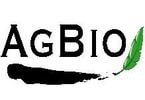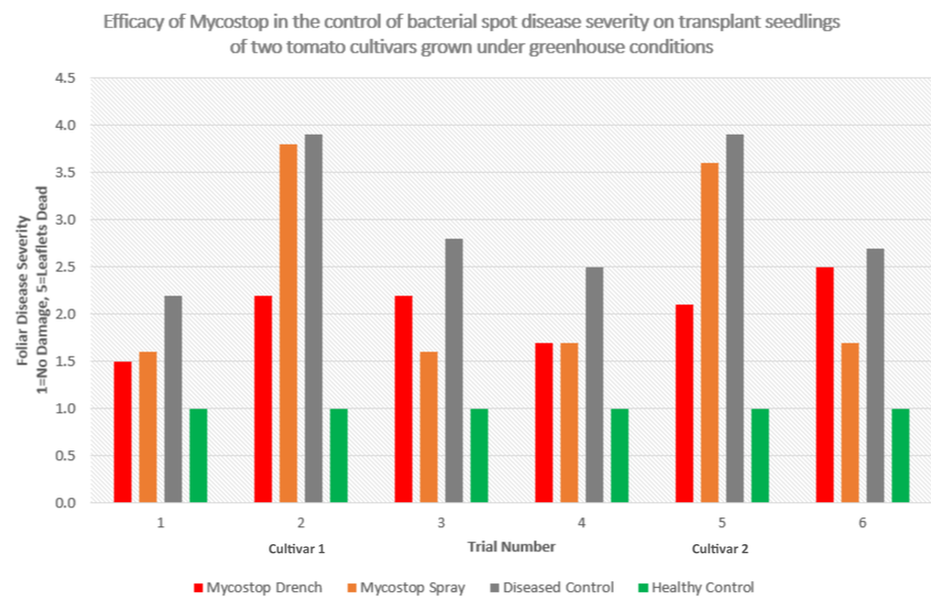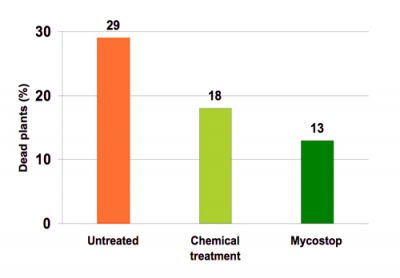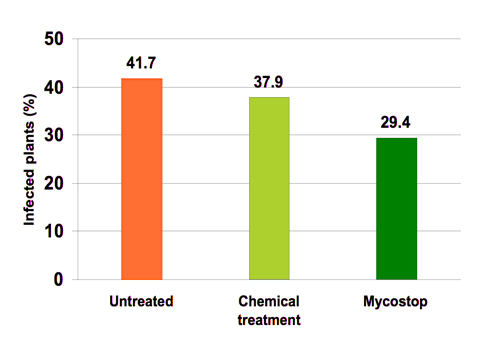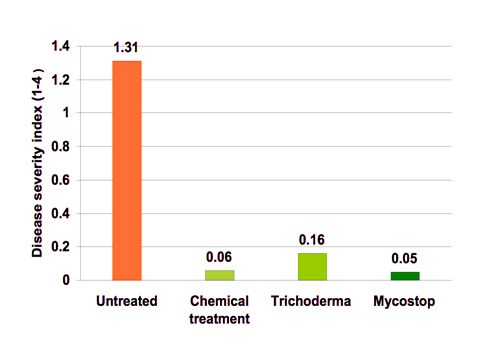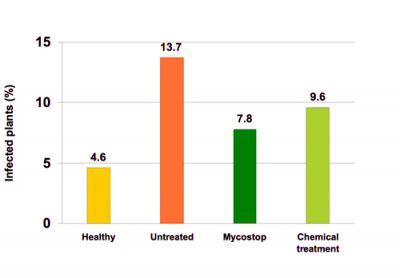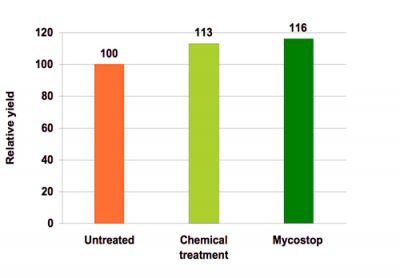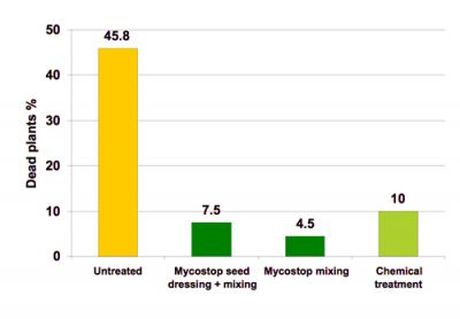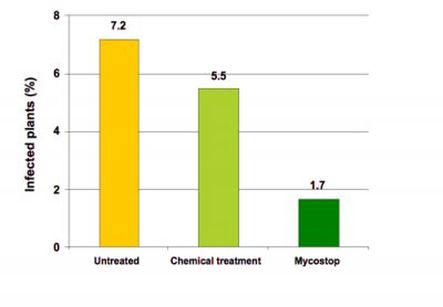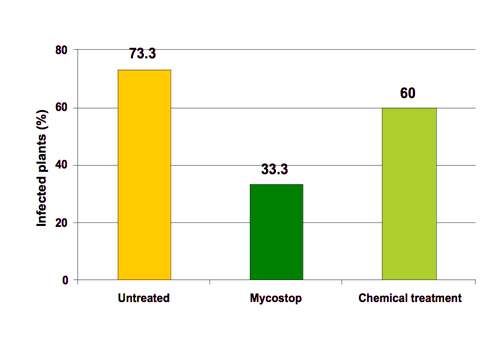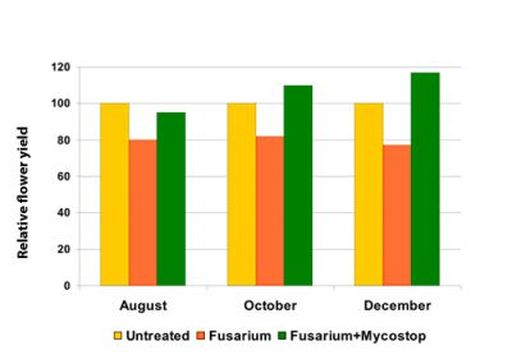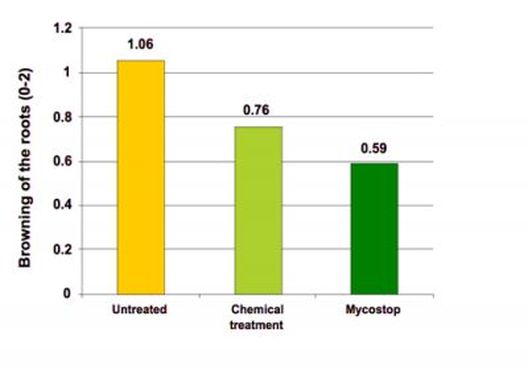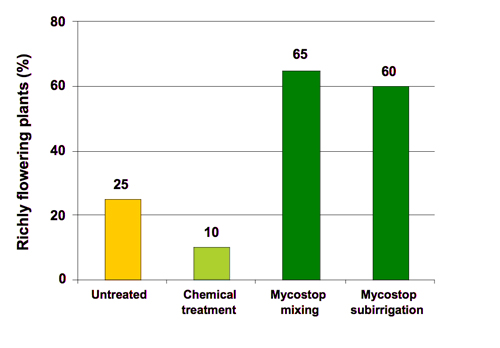Mycostop Suppression/Control of Bacterial Spot in Greenhouse Tomatoes
-Cuppels, et. al. Biological Control 67 (2013) 361-372
-Labeled rates
-Soil drench applied 4 days before bacterial inoculation
-Foliar spray applied 4 days before and 7 days after bacterial inoculation
-Labeled rates
-Soil drench applied 4 days before bacterial inoculation
-Foliar spray applied 4 days before and 7 days after bacterial inoculation
Mycostop Increases Cucumber yield
- UK 1994
- Cultivar Jessica
- Cultivation in re-used rockwool plates
- No artificial infection
Application:
- Mycostop 10 mg/plant every 4 weeks
- Chemical treatment: propamocarb 0.06 ml/plant every 4 weeks
- Cultivar Jessica
- Cultivation in re-used rockwool plates
- No artificial infection
Application:
- Mycostop 10 mg/plant every 4 weeks
- Chemical treatment: propamocarb 0.06 ml/plant every 4 weeks
Control of Pythium on Greenhouse Cucumber
|
- The Netherlands 1993
- Cultivation in re-used rockwool plates - Natural infection with Pythium sp. Application: - Mycostop 10 mg/plant first treatment before planting, three repetitions - Chemical treatment: propamocarb-hydrocloride 0.1% 200 ml/plant after planting |
- Finland 2000
- Commercial garden - Plants on rockwool Application: - Mycostop 0.05% suspension 15 ml/plant - Chemical treatment: propamocarb-hydrocloride 0.15% 100 ml/plant - Drench after transplanting |
Control of root and stem rot on Greenhouse Cucumber
- Canada Simon Fraser University 2001-2002
- Cultivation on rockwool
- Conditions similar to commercial plant production
- Seeds artificially inoculated with Fusarium oxysporum f.sp. radicis cucumerinum
Application rates:
- Benomyle drench 12.5 ml/plant
- Mycostop drench 1.0 g/l
- Trichoderma drench 0.9 g/l
- Cultivation on rockwool
- Conditions similar to commercial plant production
- Seeds artificially inoculated with Fusarium oxysporum f.sp. radicis cucumerinum
Application rates:
- Benomyle drench 12.5 ml/plant
- Mycostop drench 1.0 g/l
- Trichoderma drench 0.9 g/l
Control of wilt on Greenhouse Tomato
|
- Italy 2001
- Cultivar Cuore di Bue tipo Pearson - Artificial infection with Fusarium oxysporum f.sp lycopersici - Cultivation in soil Application: - Mycostop drench 5 g/100m2 - 2 treatment at intervals of 4 weeks - Chemical treatment: benomyle drench 4 g/m2 |
- Hungary 1992
- Cultivar Credito - Natural infection with Fusarium oxysporum f.sp lycopersici - Cultivation in soil Application: - Mycostop drench 12.5 mg/plant - Treatment every 4 weeks - Chemical treatment: benomyl 50% drench 0.1 g/m2 |
Controlling Pythium on Basil
- Italy 2001
- Cultivar Genovese gigante
- Artificial infection with Pythium ultimum
- Cultivation in soil
Application rates:
- Mycostop seed dressing 8 g/kg seeds + growth substrate mix 5 g/m3
- Mycostop growth substrate mix 10 g/m3
- Chemical treatment: propamocarb-hydrocloride 8 ml/m2
- Cultivar Genovese gigante
- Artificial infection with Pythium ultimum
- Cultivation in soil
Application rates:
- Mycostop seed dressing 8 g/kg seeds + growth substrate mix 5 g/m3
- Mycostop growth substrate mix 10 g/m3
- Chemical treatment: propamocarb-hydrocloride 8 ml/m2
Controlling Fusarium on Cyclamen
- The Netherlands 1993
- Cultivar Sierra mixed
- Natural infection with Fusarium oxysporum
Application:
- Mycostop drench 2 mg/plant
- Chemical treatment: tolyfluanide/iprodione 1-2g/100 m2
- Treatments every 4 weeks
- Cultivar Sierra mixed
- Natural infection with Fusarium oxysporum
Application:
- Mycostop drench 2 mg/plant
- Chemical treatment: tolyfluanide/iprodione 1-2g/100 m2
- Treatments every 4 weeks
Controlling Fusarium on Carnation
- USA 1991, University of California
- Artificial inoculation with Fusarium oxysporum f.sp. dianthi
- Organic growth substrate
Application:
- Soaking of cuttings in 0.1% Mycostop-suspension + Mycostop drench 0.1 g/m2 every 4 weeks
- Chemical treatment: fosetyl Al 6.0 g/l every 2 weeks
- Artificial inoculation with Fusarium oxysporum f.sp. dianthi
- Organic growth substrate
Application:
- Soaking of cuttings in 0.1% Mycostop-suspension + Mycostop drench 0.1 g/m2 every 4 weeks
- Chemical treatment: fosetyl Al 6.0 g/l every 2 weeks
Controlling Fusarium on Gerbera
- Finland 1990
- Cultivar Party
- Cultivation on rockwool
- Artificial inoculation with Fusarium oxysporum
Application rate:
- Spraying with 0.1% Mycostop- suspension
- Treatments monthly
- Cultivar Party
- Cultivation on rockwool
- Artificial inoculation with Fusarium oxysporum
Application rate:
- Spraying with 0.1% Mycostop- suspension
- Treatments monthly
Control of root diseases on Gerbera
- Finland 1994
- Artificial inoculation with Phytophthora sp.
Application:
- Mycostop drench 10 mg/plant
- Chemical treatment: propamocarb-hydrocloride drench 0.15% 20 ml/plant
- 4 treatments every 4 weeks
- Artificial inoculation with Phytophthora sp.
Application:
- Mycostop drench 10 mg/plant
- Chemical treatment: propamocarb-hydrocloride drench 0.15% 20 ml/plant
- 4 treatments every 4 weeks
Mycostop on Campanula
- Finland 2002
- Natural infection of Phytophthora sp.
- Subirrigation via wetting mat
- Observations 2 months after potting
Application:
- Mycostop 5 mg/plant
- Application at potting via wetting mat or by mixing into the potting media
- Chemical treatment: fosetyl aluminium 0.4 g/ plant
- Application at potting by mixing into the potting media
- Natural infection of Phytophthora sp.
- Subirrigation via wetting mat
- Observations 2 months after potting
Application:
- Mycostop 5 mg/plant
- Application at potting via wetting mat or by mixing into the potting media
- Chemical treatment: fosetyl aluminium 0.4 g/ plant
- Application at potting by mixing into the potting media
|
American Phytopathology
Society |
© 2009-2022 AgBio, Inc.
